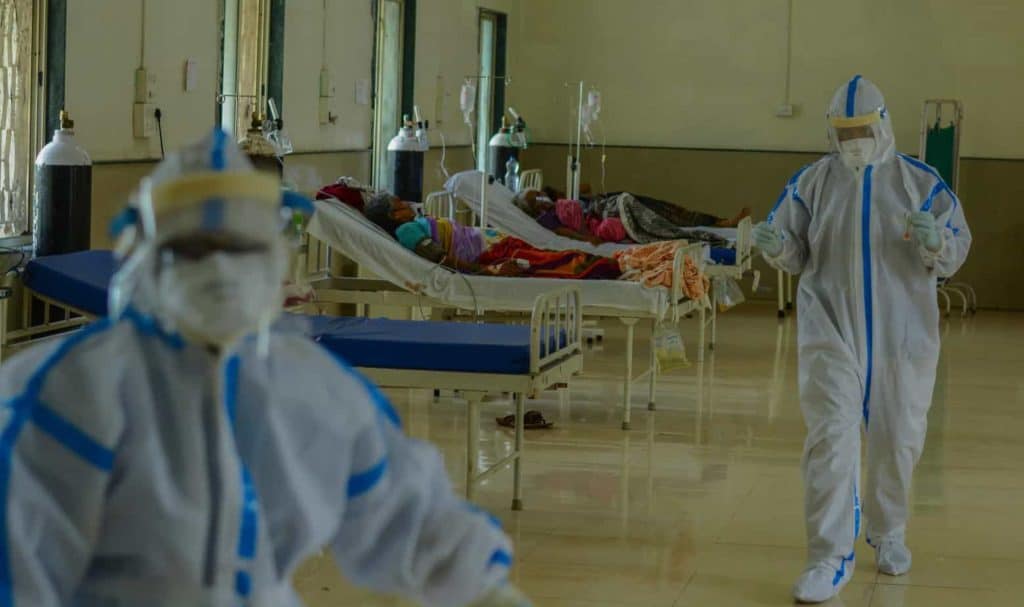Omicron, named by the WHO after the 15th letter of the Greek alphabet, continues to fuel the third wave of Covid-19 pandemic in India. On Jan 20th, the country witnessed a whopping 3.47 lakh cases, the highest in the last eight months. Globally, India is the second worst-hit country after the US.
The Omicron variant, which has over 30 mutations on its spike protein, hit the country at a time when people believed that the pandemic was nearing the end. It has so far been found in 29 states.
In fact, Omicron is fast becoming the dominant variant which, experts say, is because of its high transmissibility, immune escape ability, or both. As far as the severity of the disease it causes is concerned, some findings suggest that it is causing mild symptoms, while others suggest that the variant can lead to a greater number of hospitalizations in children as compared to other variants.
Read more: Is Omicron really ‘mild’? Hear from the doctor who first spotted it
Several modelling studies have been done in India and across the world to predict how the current Omicron wave could affect India and other countries.
A Mckinsey study predicates a base-case scenario in which Omicron, as compared to Delta, is about 25% more infectious, displays escape immunity to a greater extent (by about 25%), and leads to less severe disease, by about 25%. The study, focussing primarily on the US, suggests it has the potential to overwhelm the healthcare system.
An India-centric modelling study by researchers at the Indian Institute of Science and Indian Statistical Institute (IISc-ISI) claimed that the country could witness over 10 lakh COVID cases a day by the end of January or the beginning of February.
The many modelling projections
“Projections January-March 2022 IISc-ISI Model’ by Professor Siva Athreya, Professor Rajesh Sundaresan and the team from the Centre for Networked Intelligence at IISc-ISI in Bengaluru predicts that the third COVID wave may peak in January.
On the contrary, an analysis by the IIT Madras’ Department of Mathematics and Centre of Excellence for Computational Mathematics and Data Science shows that the R-value (rate of infection spread) of Omicron has been declining by the week. Between December 25-31, it was 2.9, the next week it went up to 4, then reduced to 2.2 in the week of January 7-13 and to 1.57 in the week of January 14-21.
However, some experts also believe that this time the disease is not as severe as it was during the Delta-driven second wave. According to a recent study done by Max Healthcare hospitals at their 13 hospitals across the country, of the total hospitalisation numbers across Max healthcare hospitals, 63% of patients needed oxygen support during the first wave, 74% during the second wave, and 23.4% during the current wave. There were fewer hospitalisations as well, even though the number of positive cases during the current wave reached the same levels as the previous wave.
The study which was conducted under Dr Sandeep Buddhiraja, group medical director, Max Healthcare, states that although the total number of cases in Delhi peaked at about 28,000 during the second and the third wave, the highest number of patients admitted at the Max hospitals was 2,000 during the second wave. However, this time the highest number of admissions was around 415. Besides, last time over 70% of the patients admitted needed oxygen support. During this wave, less than 25% patients need oxygen support and almost all of them are admitted to the ICUs.
Read more: Omicron variant crushes hopes for a virus-free 2022
“The current Omicron wave is not causing much severe disease due to the change in the spike protein,” says Dr Sanjeev Misra, director, AIIMS, Jodhpur. “More than 80% cases are mild or asymptomatic. Very small percentage of cases requires oxygen support or hospitalization. Those with the comorbidities, mainly hypertension, diabetes, cardiovascular diseases, renal, tuberculosis and COPDs in higher age group, may have severe manifestations.”

Experts are unanimous when it comes to measures the country needs to take to contain the pandemic. “Masks are considered to be the best and the first line of defence against the transmission of the virus,” says Dr Mishra. “Triple layer surgical masks, as well as cloth masks, are effective if they are properly used. The disposal of surgical masks is equally important to prevent transmission”.
Vaccination is helping in reducing the severity of disease in a majority of people, add experts. “Vaccination and Covid appropriate behaviour will help the country deal with the rising number of cases and in reducing the mortality in vulnerable groups,” reiterates Dr N K Arora, a member of the National Covid-19 Task Force.
| State | Number of cases | Deaths |
|---|---|---|
| Delhi | 11,486 | 45 |
| Punjab | 7,699 | 33 |
| UP | 16,000 | 16 |
| Karnataka | 42,470 | 26 |
| Haryana | 8,753 | 11 |
| Assam | 5,580 | 13 |
| Mizoram | 1,116 | 4 |
| Bihar | 3,000 | 10 |
Figures as on January 22nd
The end predicted
Professor Manindra Agarwal of IIT Kanpur has said that the third wave of the pandemic will end by April. With the important caveat: ‘provided all COVID related precautions are taken’. Professor Agarwal bases his prediction on his mathematical model, which predicts 1.8 lakh cases a day even after the third wave ends. In fact, in his model, Professor Agarwal had predicted that Bangalore will reach its peak around January 23rd.
Another factor for an end to the pandemic, said Professor Agarwal, was that 80% of the population in Africa and India is below 45 years of age and natural immunity is up to 80% in both countries.